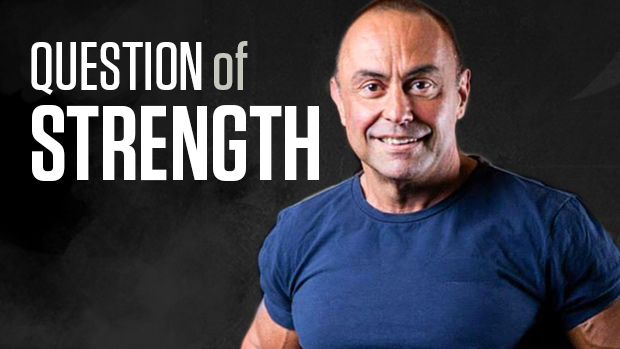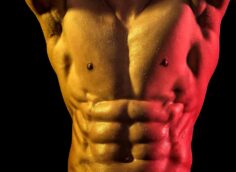Question: Let's say that I wanted to devise an extended program based solely on your training principles: GVT, GBC, the 1-6 Principle, and Maximal Weights. Yeah, I know, I'm a glutton for punishment. How would you recommend scheduling these different phases?
Assuming that your goals are to gain size and strength and improve your body composition, I suggest the following periodization model:
Phase 1 – German Body Composition
This phase provides a very sound general conditioning base. It should lean you out considerably and improve your anaerobic endurance. Your maximal strength probably won't go up too dramatically, but strength endurance should climb. In other words, you'll be able to do a greater amount of reps at a given weight than you could otherwise. Of course, people with a high percentage of type II-A fibers, like TC, have made substantial gains in size on it. Contrast that with someone like me, who just leans out from the program because of a heavy concentration of FT II-B fibers.
Phase 2 – Maximal Weights (see Issue 1 of Testosterone)
After a phase of high volume like German Body Comp training, your nervous system will welcome an intensification phase like this one. The program will make your maximal strength levels soar so that you can start the following hypertrophy phase at a higher-than-normal level of overload.
Phase 3 – German Volume Training (see Issue 59 of Testosterone)
In a nutshell, for those of you who aren't familiar with GVT, it consists of doing ten sets of ten on specific exercises. Since you'll be coming directly off of a strength phase, your average load for this type of hypertrophy training will be high and, thus, you can expect to apply a better overload and, therefore, reap more muscle mass gains than usual.
Phase 4 – The 1-6 Principle (see Issue 58 of Testosterone)
This will finish off your cycle nicely, since it's a hybrid method that combines both strength and hypertrophy stimuli. I'd suggest doing each program for about three weeks, so this total road to "buffness" would take about 12 weeks.
Question: You and Ian King have convinced me that I should incorporate power cleans and deadlifts into my program. Where should I put them? Should I do them on leg or back day? I am sore in the legs, back, and traps after deadlifting and have the same problem with power cleans. Any suggestions?
Power cleans or deadlifts are to be done on leg day, since they overload the powerful hip and knee extensors. If you choose to do power cleans, make sure that you do them first in the workout – they require a lot of coordination. Doing them last might cause you to wreak havoc on the gym, yourself, and the people around you.
If you're on a program that aims at driving up your power clean or deadlift, make sure to cycle your squatting workouts appropriately according to your level of recovery ability. The number of mutants out there that can naturally drive up their squats and deadlifts at the same time – the last time I checked – is very, very low.
You may also want to watch the amount of indirect work, such as bent-over barbell rows, that you do for the lower back. I remember having dinner with exercise rehab specialist Paul Chek a couple of years ago and, of course, the topic of training came up. Paul was complaining that none of his lifts were increasing. I asked him some questions about how he was training, and the reason for his plateau became obvious: he wanted to improve his squat, deadlift, and bent-over row poundages at the same time.
My advice to him was rather simple: choose one of those three lifts and work hard at it for three to four weeks, then switch to another lift.
Question: Okay, big guy, you don't seem to get much criticism. I have a feeling that it's because you "walk the walk and talk the talk," i.e. you aren't some kind of flabby, armchair expert. In fact, the only thing negative that I've heard about you is that your training principles are designed primarily for athletes, not bodybuilders. If you want to improve performance, they say, talk to Poliquin. But if you're interested in getting bigger, there are better ideas out there. So, how do you answer these criticisms?
The main reason that I work with athletes and not bodybuilders is a financial one. In other words, as Dan Duchaine has pointed out, bodybuilders would rather spend money on Deca than sound training advice. Dan even admitted to me once that he didn't think training was very important for size gains until he tried my stuff.
You're mistaken, though, if you think that my advice doesn't help to increase muscle mass or lose fat. My average NHL hockey player loses 11 pounds of fat and gains 18 pounds of muscle mass in just 11 weeks of summer training. If you're interested in reading about what sort of progress my athletes experience.
Also, there are currently four sports agencies who send me athletes for that very purpose. Just ask the NHL hockey enforcers who've had to deal with my client, 236-pound Anaheim Mighty Ducks enforcer Jim McKenzie. Jim packs a punch that will knock you into next week. Read my Achieving Structural Balance article from Testosterone Issue 52 for more details.
Furthermore, when I started working with bobsledders, the average bodyweight was in the 187-pound range. Just one Olympic cycle later, the average bodyweight was up to 231 pounds. By that time, we had the fastest start in the world. In 1998, we took the gold medal in the two-man, becoming the first non-German speaking nation in Olympic history to win that event.
Now, come on, do you really believe that bodybuilders are the only ones who need to gain size and lose body fat?
Question: I hear all the time how great lunges are for legs, but when I do them the only thing that gets sore is my ass! That's fine by me, but shouldn't I be feeling something in my quads? I usually start my program with lunges, since they require more balance, and then move on to hamstring curls and calves.
One of my colleagues, known in the industry for his ab-training knowledge, was complaining about the same thing a few years ago while visiting me in Canada. In fact, he had an ass that stuck out two feet, but his legs were so poor that Colonel Sanders, if he were still alive, would've coated them with his 11 secret herbs and spices. This particular trainer was doing lunges with 225 pounds, using his interpretation of proper technique. Some of my other colleagues were there, too, and we started to razz Jennifer Lopez-butt for having DTS (Dork Technique Syndrome). Once he swallowed his ego and agreed that his technique was pathetic, he lowered the poundage to 115 pounds. After making those adjustments, the pain shifted to its proper "home."
If done properly, lunges should make you sore not only in the glutes, but also in the hamstrings, quads, and adductors. If you're only getting soreness in the glutes, it means that your lunge technique is on the wussie side – most likely, your stride is too short and you lean forward too far.
In the stretched position, the bottom six inches of your hamstrings should fully cover your gastrocnemius muscles. In other words, in the stretched position, you should see no daylight between the hamstrings and calves. Your torso should be as upright as possible; in fact, it should be perpendicular to the ground.
Give the proper technique a try and see if you can walk upstairs tomorrow without cursing me and my descendants. I can guarantee, though, that if you do them the way that I've described, your leg hypertrophy should shoot right up.
Question: What's the deal with sprinting and, for lack of a better term, big-toe power? A coach once told me that you could actually sprint faster by training your big toe. Of course, he had no idea how to train the big toe. Is there any truth to this?
Lest anyone think that this question is a joke, there actually was a study done in Finland showing that training the toe flexors really did improve sprinting speed.
If you want to train the toe flexors, lay an unfolded beach towel on the floor and place a weight at the far end of the towel. While standing, place your bare foot on the opposite end of the weighted-down towel and pull it toward you by opening and clenching your toes. When the weight reaches your foot, repeat with the other foot.
Of course, you could forget the whole thing and just concentrate on increasing your squat poundages instead, which should work far better than all of the toe scrunches in the world.





